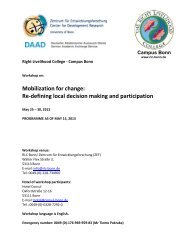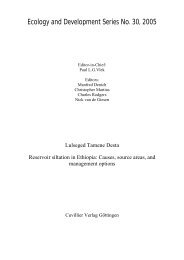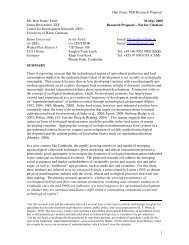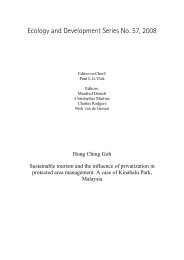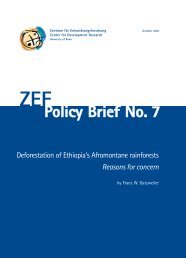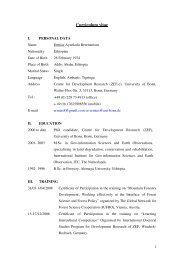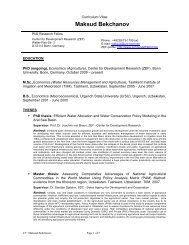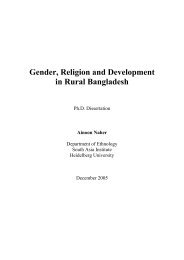Ecology and Development Series No. 10, 2003 - ZEF
Ecology and Development Series No. 10, 2003 - ZEF
Ecology and Development Series No. 10, 2003 - ZEF
- No tags were found...
You also want an ePaper? Increase the reach of your titles
YUMPU automatically turns print PDFs into web optimized ePapers that Google loves.
Current state of knowledgeAgaro, Chochie, Zeghie, Wolkitie, Wallamo, Irgalem, Dilla, Arba Gougou, Harar <strong>and</strong>Loulo. He also admitted that his list of the distinct cultivars was not complete due to theinability to cover all coffee growing regions. Over 130 traditional l<strong>and</strong>races or farmers’cultivars have recently been recorded from different coffee growing regions of Ethiopia(Admasu et al. 1989; Demel <strong>and</strong> Assefa 1994; Tadesse et al. 2001). The distinctness ofthese cultivars needs further investigation. Known cultivars of C. arabica growing outsideof Ethiopia include ‘Blue Mountain’ in Jamaica, ‘French Mission’ in Kenya <strong>and</strong> Tanzania,‘Kent’s’ in India, ‘Mundo <strong>No</strong>vo’ in Brazil, ‘San Ramon’ <strong>and</strong> its segregate ‘Villalobos’ inCosta Rica to mention a few, which are derived from two main lines of cultivars (van derVossen 1985; Anthony et al. 2002).2.2.2 Genetic diversityCoffea arabica differs from other species in the genus in that it is the only tetraploid(2n=44) <strong>and</strong> self-fertile species. All others are diploid (2n=22) <strong>and</strong> self-infertile (Carvalho1952; Charrier <strong>and</strong> Berthaud 1985). Morphologically, C. eugenioides <strong>and</strong> C. congensis aremore similar to C. arabica (Friis 1979). Carvalho (1952) observed that C. arabica exhibitsthe cytogenetical behavior of allotetraploid plants, indicating that it has evolved from across between two wild diploid species. Based on morphological characteristics of hybridsof diploid coffee species <strong>and</strong> the haploid progenies of C. arabica, it has been suggested thatC. eugenioides <strong>and</strong> C. congensis (or C. canephora or C. liberica) are the putative diploidprogenitors of C. arabica (Carvalho 1952; Narasimhaswamy 1962; Charrier <strong>and</strong> Berthaud1985). On the other h<strong>and</strong>, Monaco (1968) argued that Coffea arabica could also be anautotetraploid species <strong>and</strong> suggested investigating other chromosome races in the wildpopulations of the species in Ethiopia.A definite conclusion on the origin of the diploid species parenting C. arabica hasnot yet been reached. However, recent analysis of the phylogenetic relationships of Coffeaspecies using internal transcribed spacer (ITS) sequences of nuclear ribosomal DNA placedC. arabica in a group which encompasses diploid species originating from West <strong>and</strong>Central Africa (Lashermes et al. 1997). The diploid species in this group (also calledcanephoroid group) include C. canephora, C. brevipes, C. congensis, C. humilis, C.16



